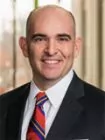In Short
The Decision: The Federal Energy Regulatory Commission ("FERC") issued Opinion No. 569-A, refining the methodology it established in Opinion No. 569 for setting the return on equity ("ROE") that electric utilities earn on electric transmission investments.
The Impact: Opinion No. 569-A increased the Midcontinent Independent System Operator, Inc. transmission owners' ROE from 9.88% to 10.02%.
Looking Ahead: In the near term, there is increased uncertainty as a result of FERC changing their approach in Opinion No. 569. In the long term, Opinion No. 569-A may reduce perceived risks and bring greater stability to transmission ROE if the methodology proves durable.
On May 21, 2020, FERC issued Opinion No. 569-A, further refining the methodology it established in Opinion No. 569 for setting the ROE that electric utilities are authorized to earn on electric transmission investments.
In Opinion No. 569-A, FERC granted rehearing of Opinion No. 569 to make several adjustments to the methodology set forth in Opinion No. 569. The ultimate effect of these changes was to increase the Midcontinent Independent System Operator, Inc. transmission owners' ROE from 9.88% to 10.02%. These revisions to the methodology prescribed by Opinion No. 569 touch on all aspects of FERC's approach:
First, after specifically disclaiming it in Opinion No. 569, FERC decided to use the Risk Premium model instead of only relying on the Discounted Cash Flow ("DCF") model and Capital Asset Pricing Model ("CAPM") under both prongs of Federal Power Act ("FPA") Section 206. FERC stated that "the defects of the Risk Premium model do not outweigh the benefits of model diversity and reduced volatility resulting from the averaging of more models." FERC declined, however, to reconsider the use of the Expected Earnings model.
Second, FERC adjusted the relative weighting of long- and short-term growth rates, increasing the weight for the short-term growth rate to 80% and reducing to 20% the weight given to the long-term growth rate in the two-step DCF model. FERC, citing Opinion No. 414-A, stated that "long-term projections are inherently more difficult to make, and thus are less reliable than short-term projections." As such, FERC believes it is appropriate to consider the long-term growth rate to some extent, but that it is appropriate to afford less influence to the long-term growth rate.
Third, FERC modified the high-end outlier test to treat any proxy company as high-end outlier if its cost of equity estimated under the model in question is more than 200% of the median result of all the potential proxy group members in that model before any high- or low-end outlier test is applied, subject to a natural break analysis. This is a shift from the 150% threshold applied in Opinion No. 569. FERC stated that it recognized a test with such a bright-line threshold could exclude ROEs that are rational and not anomalous for the subject utility. By raising the threshold to 200%, it will reduce the risk that such rational results are inappropriately excluded. By continuing to apply the natural break analysis, it still will allow the exclusion of ROEs that are truly irrational or anomalously high.
Finally, FERC decided to calculate the zone of reasonableness into equal thirds, instead of using the quartile approach that was applied in Opinion No. 569. The quartile approach excluded the bottom eighth and top eighth of the overall zone of reasonableness. In Opinion 569-A, FERC found that this was inappropriate because it ignores some "potentially lawful ROEs" when determining which ranges of ROEs should be considered presumptively just and reasonable.
Commissioner Glick wrote separately, concurring in part and dissenting in part. Commissioner Glick argued that FERC needs to "Stop the Endless Fiddling with Its ROE Methodology" and criticized aspects of Opinion 569-A as poorly reasoned and result-driven. In sum, while Commissioner Glick did not assert that the ROE determined by Opinion No. 569-A was not just and reasonable, he expressed concern that the ever-changing models and methodologies relied on by FERC to determine ROE undermine needed certainty and predictability in transmission ROE.
Looking forward, Opinion No. 569-A reflects another step in FERC's continuing efforts to adapt its traditional approach to determining ROE to market realities and investor expectations. Ultimately, a public utility's cost of capital must meet the long-standing capital attraction and retention requirements that have guided FERC's decisions for decades. Whether the revised methodology reflected in Opinion No. 569-A will adequately meet that test remains to be seen. Regulatory risk has a significant influence on utility cost of capital, and the market will require higher returns to account for such risk. In the near term, the uncertainty resulting from FERC's further changes to its ROE methodology may place some upward pressure on utility returns as the market reflects this risk. However, if the Opinion No. 569-A methodology proves to be a durable standard, it will reduce perceived risks and bring greater stability to transmission ROE over time.
The issues addressed in Opinion No. 569-A are likely to be litigated further at FERC and potentially in the appellate courts. The scope of these potential challenges will be better known in late June when parties are expected to file requests for rehearing. We will provide further updates as the proceeding moves forward.
Three Key Takeaways
- FERC revised the methodology it established in Opinion No. 569 to include the Risk Premium model instead of only relying on the DCF model and CAPM.
- Commissioner Glick argued that the ever-changing methodology undermined needed certainty and predictability in transmission ROE.
- Parties may still request rehearing of Opinion No. 569-A, and ultimately judicial review may be required, so this issue is not yet settled.
Article originally published June 2020
The content of this article is intended to provide a general guide to the subject matter. Specialist advice should be sought about your specific circumstances.



